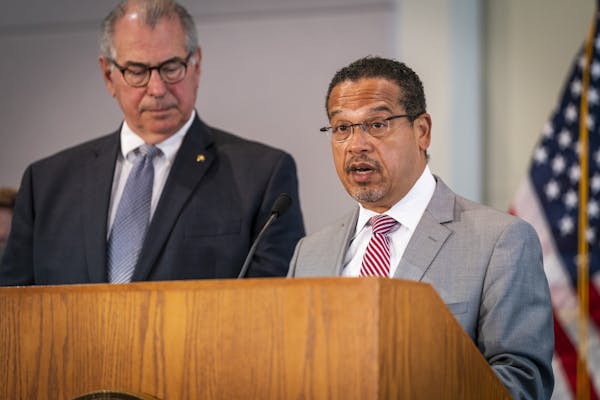Years before Minneapolis police killed George Floyd, the world saw Philando Castile's last moments on Facebook Live as a St. Anthony officer shot him in his car.
In the racially charged case, the officer, Jeronimo Yanez, was ultimately acquitted of second-degree manslaughter and endangering safety. The ruling hung on a central question: Did the officer reasonably fear that Castile was reaching for a gun, one he disclosed having when he was stopped?
That question — and the state law that prompted it — is now central to the debate as lawmakers and community leaders call for massive overhauls of policing.
During a special session of the Legislature, Democrats are pushing to dramatically change the state's deadly force statute, which allows officers to use such force when they "reasonably believe" someone will cause "death or great bodily harm" if not apprehended. Deadly force is also allowable under law if used by officers to protect themselves or others, or to capture someone they know or have "reasonable grounds to believe" has committed or will commit a felony using force.
When Rep. Rena Moran, DFL-St. Paul, reads the law, one word sticks out: "believes."
"The officer believes that something is going to happen, whether or not it is a real threat, he just believes it is," she said. "It's so open to their beliefs, or how they see the world, or how they see people of color."
That subjectivity, critics argue, allows for bias, even as officers often have to make split-second decisions about life and death.
Moran and others say the current standard gives wide latitude to officers to use force, and it has kept officers from facing charges or being prosecuted when those encounters turn deadly. Hennepin County Attorney Mike Freeman cited the deadly force law when he declined to charge the officers involved in the killing of Jamar Clark in 2016 and Thurman Blevins in 2018, both black men killed by Minneapolis police.
In 2019, Freeman successfully prosecuted former Minneapolis police officer Mohamed Noor for fatally shooting Justine Ruszczyk, a white woman, while responding to her 911 call. Noor, who is Somali-American, is believed to be the only officer convicted of murder in the history of the state.
Derek Chauvin and three other officers involved in Floyd's arrest are facing charges.
More than 100 cases of excessive use of force resulted in death or injury over the past five years, according to a state report this year on police encounters. Despite many high-profile cases occurring in the Twin Cities, 60% of those events took place outside the metro area, said Department of Public Safety Commissioner John Harrington. Half of the cases involved people in a mental health crisis.
Moran is pushing a proposal to make legislative intent clear: The authority to use deadly force is "a critical responsibility that shall be exercised judiciously and with respect for human rights." It would also require an "imminent" threat of death or harm to an officer or someone else before deadly force is used. Moran also wants the state attorney general to handle all deadly force cases, instead of local prosecutors who have close relationships with police.
Those provisions have run into strong resistance from Republicans who control the Senate. They are pushing their own proposals that direct a statewide officer licensing board to draft a policy to ban tactics like chokeholds and neck restraints, such as those used on Floyd. The bill would also require the state board to establish sanctity of life standards respecting the value of all human life and requiring officers to intervene when they see a colleague using excessive force.
"Oftentimes when you go in, the situation has already exploded into violence. But we really want to make sure the training emphasizes sanctity of all life," said Warren Limmer, R-Maple Grove, the author of the bill. "Not only protecting the officer but the people they [interact with]."
Another proposal, from Sen. Bill Ingebrigtsen, R-Alexandria, would require law enforcement agencies to report monthly use-of-force cases to the Minnesota Bureau of Criminal Apprehension. It's something many agencies already do, he said, but requiring it would increase transparency.
"When you get down to [small] agencies, a chief and one person or two people in smaller rural communities, they are probably having more difficulty with that," said Ingebrigtsen, who spent 34 years in law enforcement.
But those hoping to change the language in the law argue it's not just about accountability after the fact: Officers would be more likely to try de-escalation or other tactics if the law was less open-ended on when they can use force.
In 1985, the U.S. Supreme Court ruled that under the Fourth Amendment officers can't shoot fleeing suspects unless they have probable cause to believe they pose a threat to the officers or others. That ruling led to a change in laws and to a 13% to 23% decrease in deadly force in states, according to a 1994 study.
"The idea is to instill a new culture, a new belief system, so that when there's training and awareness made of these laws, officers know that something is different," said Jim Hilbert, a Mitchell Hamline School of Law professor and civil rights attorney. "That's the whole point of laws: to help encourage certain behaviors and then provide accountability when people don't match what the law requires."

Trail section at one of Minnesota's most iconic spots closing for rehab

Will 'shotgun only' zone for deer in southern Minnesota be abolished?

Four Minnesotans catch salmonella in outbreak linked to basil sold at Trader Joe's

